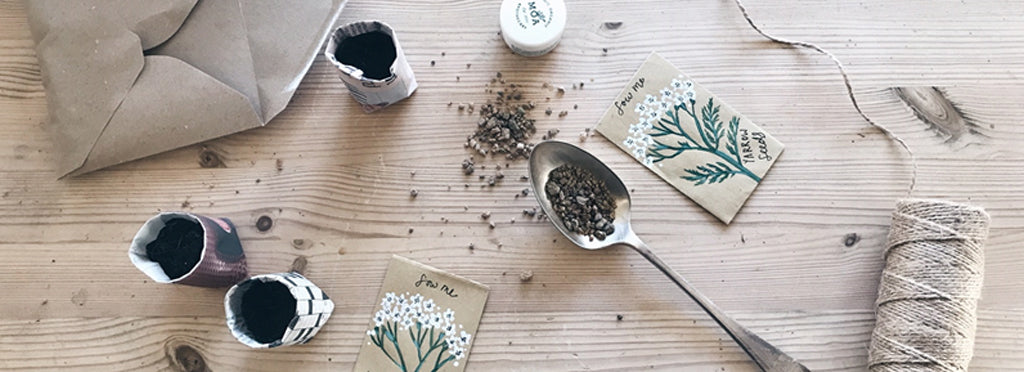
Yarrow a magical herb and gardener’s friend.
Our hero herb Yarrow is steeped in myth and legend, which is partly why I love it so. It grows almost everywhere across the globe, it is one of the world’s oldest medicinal plants and has been used since ancient times to protect and heal.

This humble herb is great for nature and extremely helpful in the garden, its mass of pretty white flowers are long lasting throughout the summer, attracting beneficial insects, ladybirds, hoverflies, bees and butterflies. It helps to improve soil quality, enriching the soil around it. Yarrow is a member of the Asteraceae daisy family, it is easy to grow and will thrive in a sunny spot, it makes a wonderful addition to a flower bed or wildlife garden, protecting surrounding plants from disease and keeping harmful pests away with its potent aromatic phytochemicals.

Sowing yarrow seeds for the summer
To celebrate spring, I thought it might be a nice idea to plant some seeds with my children and watch them germinate on a sunny window sill. A simple task, as long as we remember to water them a little and often! The plan is to plant them in the garden once they are established seedlings, they should take a month or so, so it’ll be a lovely project for the Easter holidays. If you’d like to do the same, here’s what you’ll need, which you can buy at your local garden centre:
Some wild yarrow seeds (available to buy online) or you can also some find vibrant colourful yarrow variations too, in deep pinks and yellows
Some biodegradable seed pots, you can buy these, but I made some out of an old newspaper!
Some gravel and compost
A tray or plate to put them on.
The cycles of the moon have influenced gardeners from diverse cultures over many centuries, the new moon phase is the most suitable time for sowing seeds, so if possible, sow your yarrow seeds as soon after, the new moon on 4th April.

Carefully pour out the yarrow seeds from their envelope onto a piece of paper, watch out they are TINY! Place a little gravel in the bottom of your seed pots for drainage and fill with compost almost to the top. Please a few tiny yarrow seeds on the surface and then cover with a thin layer of more grit. Place on a sunny window sill. Water a little and often to keep the compost slightly damp, do not over water! When the seedlings are at least 5cm, and looking stronger, leafy and fuller, you can plant them in a flower bed to start working their magic.
Not only does yarrow have a wealth of magical folklore and an ancient healing history, but its ability to heal and repair is second to none and its leaves have been used since ancient times to heal cuts, wounds and burns. When we launched The Green Balm, I realised that this humble herb was massively overlooked and I could barely find it in any skin care products, astonishing really as it seems to be a firm favourite amongst many herbalists, with its lengthy list of remedies for health and skin.
Yarrow has many funny nicknames including Nosebleed and Old Man's Pepper, in fact if you have a nosebleed, you can stuff the leaves up your nose to stop the blood flow! Antiseptic and anti- inflammatory, it has a dual ability to rapidly staunch blood flow, whilst also circulating oxygen around the wound. Achillea, as it’s sometimes known, is named after Greek hero Achilles who legend has it, used the herb to heal his soldiers wounds after battle, hence its other nick names, Soldier's Woundwort and Herbal Militaris.
With its distinctive feathery fern-like leaves Yarrow (Achillea millefolium ) is also named millefoil, or thousand leaves, because of its finely-divided leaves.It grows abundantly beside roadsides and paths, I like to forage for yarrow in the early summer and keep a stash of dried yarrow flowers and leaves to make tea… steep this herb in hot water and its cooling properties help to break a fever, inducing sweating without raising body temperature, it really is a miracle!
